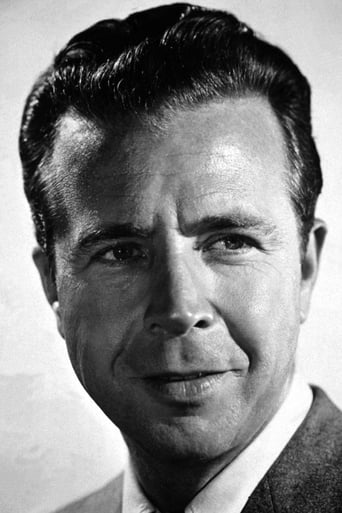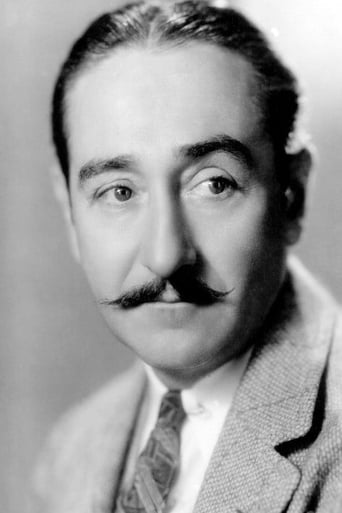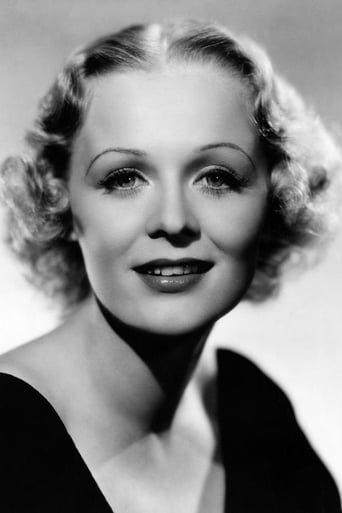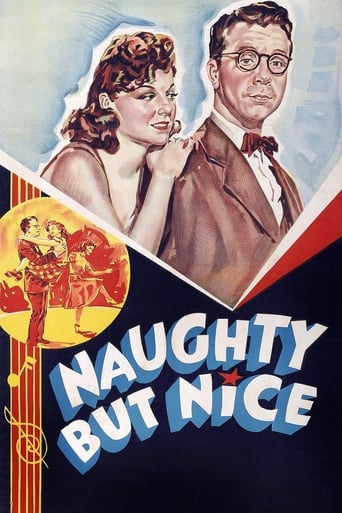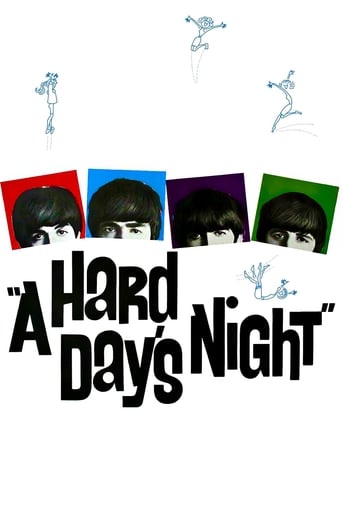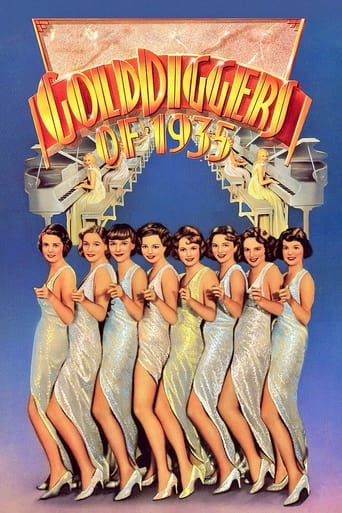

Gold Diggers of 1935 (1935)
Romance strikes when a vacationing millionairess and her daughter and son spend their vacation at a posh New England resort.
Watch Trailer
Cast
Similar titles
Reviews
Good movie but grossly overrated
It's hard to see any effort in the film. There's no comedy to speak of, no real drama and, worst of all.
It’s not bad or unwatchable but despite the amplitude of the spectacle, the end result is underwhelming.
what a terribly boring film. I'm sorry but this is absolutely not deserving of best picture and will be forgotten quickly. Entertaining and engaging cinema? No. Nothing performances with flat faces and mistaking silence for subtlety.
This superb film is a spectacular presentiment of the evil already brewing in 1935; encompassing the relationship between capitalism and the great economic depression soon to culminate in the eruption of World War II, five short years later; and the silliness and inanity of the gold digging frivolity with which it was being preceded. It is only with the wisdom of the hindsight of multiple decades that Berkeley's instinctive perceptions of the evil to come can be fully appreciated. The unsurpassed climactic finale is both a reflection of the rise of fascism, and an anticipation of the catastrophe which would ultimately unwind. It's high art, besides the uniquely impressive musical numbers. The much derided plot is actually highly witty, and there is plenty of well-delivered, humorous dialogue. I found it funny, as well as disturbing. It should be understood as a satiric comment on the times, similar to the Berlin atmosphere later depicted in Cabaret. "Stop chewing on my fingers", says the deluded matron.
. . . to rivet America's attention on how worthless the country's Richest One Per Cent are to the rest of us. While rival outfits such as MGM tried to fill American minds with fantasies such as the WIZARD OF OZ and GONE WITH THE WIND, Warner kept crashing to the forefront of the Public's consciousness with their gritty exposes, such as director William A. Wellman's HEROES FOR SALE or choreographer/director Busby Berkeley's numerous extravaganzas, including GOLD DIGGERS OF 1935. Though Warner was infamously frugal (this flick is filmed in black and white, after all), Busby was an expert on making a C-note look like a million bucks on-screen. GD35 culminates with one of those phony baloney "charity" functions, in which the One Per Cent make sure that 99% of the money "raised" is frittered away on pointless excess for their own wicked amusement. This show-within-the-movie (for a "Milk Fund") begins with what appear to be 88 white-gowned female concert pianists plunking away at 88 Steinway grand pianos frivolously ruined with milk-white paint jobs. Act Two shows former WWI drill Sgt. Berkeley's true stripes. Flypaper heiress Ann Prentiss at first is in a milky-white garbed audience of two, watching 198 frenetic tap dancers sweating for her pleasure on a cavernous stage. But then Berkeley concludes this piece by having normal people shove One Per Center Ann out of a high-rise window! Warner is doing all it can short of spelling out on the screen "Rise up, you pawns!" to keep America a free country (as opposed to the MGM-style Bread & Circus Show it is today).
I consider this a failure, mostly because I had been so imaginatively tickled by the wonderful earlier films in the same cycle of Warners musicals.In the earlier Gold Diggers from '33 and Footlight Parade, song and dance were only the voluptuous expression of a hardened heart learning to beat truthfully. The wrap-around into narrative was about the circumstances drawn from the depressions of actual life seducing inspiration out of both participants and viewers. Their gaudiness was eloquent, revealing a heart that was rich in many ways.This is the debut proper of the man who was responsible for staging the visions in those films, the actual films being about this man staging the visions. Both those were about Busby Berkeley making films.Not to imply that the man's talents had reached a certain meridian, because we find here one of the most astonishing set pieces he concocted; pure Hollywood dreaming about a woman dreaming a Hollywood that eventually plunges her to a neon doom. Film history has noted this piece as avant-garde, and has grouped it together with other early attempts at an American surrealism.But having assumed here the reigns of the entire production and not just the dance numbers, Berkeley exemplifies the expressive limitations both the surrogate filmmakers inside those films and the actual filmmakers responsible for them were called to solve; how to integrate his pure images within the environment that gives rise to them? What the actual filmmakers did, Mervyn Leroy in Gold Diggers '33 and Lloyd Bacon in Footlight, was of course to structure their films around the efforts of an impulsive artist learning to frame that intuition that so generously gave him images.Here the man is left at his own devices, with just that intuition to guide him. The result? Dazzling spectacle when the show demands it, but babbling nonsense everything around it. There is no mirror to hold the images, no reflection that reveals soul. Just a weak attempt at a farce of errors, coupled with shenanigans about marriage and money.Oh, it is again about the staging of a show, presumably the one we are meant to be watching. Various people scheme one way or another. But no one is wiser for seeing it.
Among the films Busby Berkeley was associated with, Golddiggers of 1935 is a standout. Other viewers have noted the astonishing "Lullaby of Broadway" sequence, which, yes, is everything they say it is. And the dreamy "white piano" sequence is pretty amazing, too.But you know, there's more to it. And I think you just have to chalk this up to Berkeley's drill-team background. The sequences come off with such precision.There's the crisp editing at the beginning, when the hotel managers are explaining the financial arrangements at the hotel to their employees. No pay, just tips, and make sure the managers are cut in. It's a funny bit, of course, but the way the film is assembled here accentuates the humor in a way you just don't see in your typical movie of 1935.The part that really is memorable, though, is the sequence at the beginning where Dick Powell escorts his young lovely through the hotel lobby. I guess I really ought to go back and time it, but I think it runs for something like three minutes without a cut. And all the while, hundreds of extras are rushing back and forth, and you can tell the crew must have been dashing in and moving things that were just out of camera range. You know how much work that must have took? You know how everyone on the set must have been sweating at the 2 1/2 minute-mark, worrying that someone might trip and they'd have to start all over again? I have to wonder -- how many takes were required? It's a scene every bit as complicated as the celebrated opening shot of "Touch of Evil," and maybe more so, certainly a dozen times more tricky than anything in "Rope" -- and yet this one doesn't seem to be noted anywhere in the annals of Hollywood.So let's just say that this film is one of Berkeley's most inventive and technically interesting offerings. And you know what else? It's a fun movie, too.
